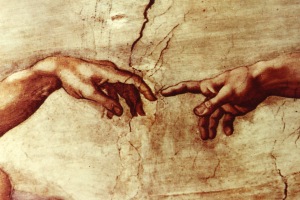The importance of touch

A few years ago there was an interesting paper in the British Journal of General Practice (BJGP) 1 exploring the use of touch in the consultation as a means of comforting and reassuring patients. The author introduced the topic by saying, ‘Touch is arguably one of the most important of the five senses classified by Aristotle. The role of touch is firmly anchored in Biblical scriptures where it served as a vehicle for blessing and healing; for example, Isaac blessed his son Jacob by laying on hands, and Jesus cured countless sick people of their ailments through touch. The amygdala is associated with emotional reactions linked to human proximity, but touch cannot be understood purely in terms of proprioceptors, dorsal root ganglia, and the like. Modern medicine need not deviate from more traditional frameworks in which touch is understood humanistically and interpersonally, involving the expression of empathy and solidarity. Touch has the potential to communicate, soothe, and heal, and medicine is diminished if it avoids the exploration and utilisation of the power of touch.’
The author decided to explore patients’ perceptions of reassuring touch in the consultation, and so distributed 220 questionnaires to patients over a three month period asking about how they felt or would feel if touched appropriately (on the lower arm, hand or upper back/shoulder) by a male or female doctor (the patient’s gender was also recorded). 196 were returned. They showed that touch by a male doctor would comfort 75% of male patients and 83% of female patients (overall 80%), and touch by a female doctor would comfort 77% of male patients and 92% of female patients (overall 86%). The two most common reasons for patients not feeling comfortable with the use of touch for reassurance were the invasion of personal space and feelings of unease regarding the sex of the doctor. No one cited religious, cultural, or familial beliefs discouraging the use of touch in the context of reassurance, although there was relatively little socioeconomic or ethnocultural diversity in this patient sample. Obviously cross-gender touching in some cultures would be inappropriately transgressing traditional social norms.
On reading this paper I was reminded of two incidents from my own practice. Once, on the second occasion that I saw a man with severe depression (by which time he was improving a little), he said, ‘Doctor, it meant so much to me when you touched me last time you saw me – thank you so much!’ I actually had no specific memory of touching him, but he said I had just put a reassuring hand on his shoulder as he left the room, saying, “You will get better, I assure you.” The other occasion was when I was leaving Nigeria after working there for a year. I had been accompanied on many of my visits to rural health clinics by a pastor who acted as translator. As we were saying goodbye, he became quite emotional, hugged me, and said, “Thank you for touching my people.”
Touch can be used to bridge the emotional and physical gap between a physician and patient. It can directly express care, compassion, and comfort. It has the potential to play an important part in the healing process, reinforcing patient trust and concordance, triggering the body’s own capacity for self-healing. This requires a cooperative relationship in which touch is offered skilfully by the physician, and welcomed by the patient, who is a full partner in the communication. Hopefully this study’s findings will help doctors to recognise the potential value of using touch in the consultation, to remove taboos around the subject, and to contribute to the strengthening of doctor–patient relationships.
PRIME would encourage you, after the example of Jesus, to use reassuring touch appropriately with your patients, and teach your students to do likewise.
1. Singh, C. Touch in the Consultation. BJGP March 2012, 147-8
